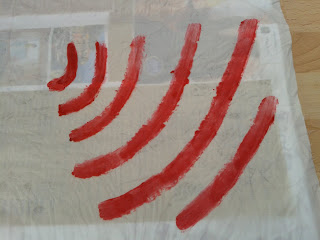My teenage sons were as helpful as they could be in working around me and what I was doing, and since they are interested in the arts and creative processes they had a reasonable understanding of what I was trying to achieve. However, there were inevitably a number of comments about such things as the smell of 'cooking' when onion skins, pine cones and so forth were brewing, and mysterious buckets, plastic containers and so on and their contents were sat brewing!
I feel I must add a note here about the impact of the health issues of my younger son. In addition to this being his final GSCE year he has recently been diagnosed with two fairly serious medical conditions consisting of both a heart defect and digestive issues. As his single reponsible parent the investigation and diagnosis of these has taken quite a toll on me both mentally and physically during the past 18 months. There are times when the stress of work plus the ongoing stream of visits to the hospital for further tests, assessments and consultations in addition to all of my other responsibilities have left me finding it very difficult to drum up the extra bit of physical and emotional energy to complete the OCA work. It is inevitable that such a situation would impinge on what I am doing, but at the same time when I do 'get stuck in' it is good that I have something of my own to channel my thoughts away from the everyday worries of life and give me personal satisfaction. This is a thought I hold on to.
Anyway, I am pleased with the work that I have done in the end for the assignment, even if I wish I could have done a lot more. I have tried to both follow the instructions and ideas of others as well as develop those of my own. To this end I even tried an experiment in using a chocolate fondue 'kit' (one we'd received as a gift and in the usual fashion used only once) as a method of melting the remains of a Christmas candle as a possible substitute for the usual batik kit. The original heat source was a tea light, and although it did melt the wax, it didn't do the job very efficiently and the wax cooled too quickly so when I peeled the stencil off all of the wax came off too! I therefore changed to using the 'bowl' in an old (another donation from a work colleague) saucepan to create a kind of bain marie which worked very well.
The tea light worked, but slowly and didn't keep the wax hot enough.
So I moved to using an old saucepan instead, and that worked a treat.
I tried painting two pieces of cotton fabric with the wax, one using a stencil I already had ...
And one just painting a simple pattern freehand
Unfortunately in the end neither of the experiments worked very well as the wax was too thick to get into the fibres of the fabric and work as a resist to prevent the dye spreading. However, you can see some of the wax pattern in the finished results so all was not totally lost. The point is that I've since thought about the problem and plan to try using the remains of some other wax candles I have as they're white, and look like they would produce a much thinner wax than the red, which I chose because it would stand out in the photographs I took! So while I intend to buy some of the 'proper' batik wax when the opportunity arises, I'm interested in trying out the white remains I have just to see what happens ...... As the song goes, "From the ashes of disaster grow the roses of success!", so it's worth having another try.
I've mentioned the above for a specific reason. The thing about these assignments is that they are the start of a journey that will never really have an end because there is always something new to try. The samples I've produced really are just the tip of the iceberg, and I've ideas for other things to experiment with next - different quantities, different timings, other ingredients and materials and so on. Like all craft work it's neverending. At first glance dyeing does seem complicated, and in many ways it is, with all the different possible combinations of farics and threads and dyes and mordants and quantities, especially if you are looking for precise results. But if you are just happy to have a go on a 'see what happens' basis then there is lots of fun to be had, sometimes with most unexpected results. And at the end of the day I think that is the whole point of the assignment, to help you learn about the processes, to develop your own ideas, and to encourage you to experiment further outside the 'confines' of both the assignment itself and the course as a whole So I've learned a lot, but can see that there is plenty more to discover.
Finally, I did try one experiment of my own which isn't strictly dyeing but rather making marks on fabric by encouraging staples and paperclips to rust while sat on them.
Here's a picture of the fabric on the tray, complete with rusting 'bits'. I've come across several references to making marks on fabric by encouraging the growth of moulds and other things on them, and am now very intrigued with the idea and have added it near the top of my list of things to try. I've no idea where this will take me, but as always it's as much - if not more - about the journey as it is about the destination.





No comments:
Post a Comment